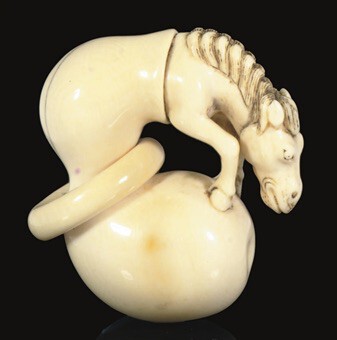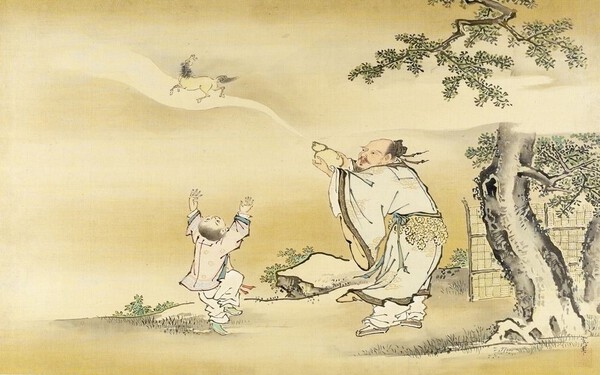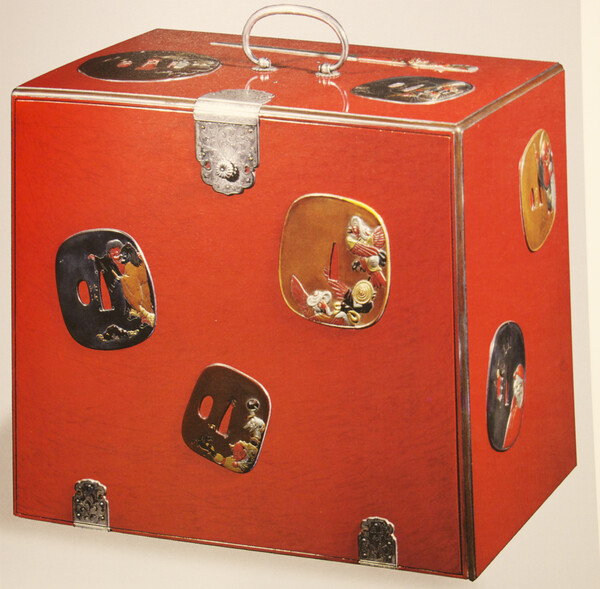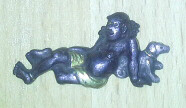-
Posts
858 -
Joined
-
Last visited
-
Days Won
7
Everything posted by Tanto54
-
Semper Fi Stephen, This is the Chokwaro Sennin motif. Chokwaro Sennin carries a gourd tied to his waist by a rope that he can conjure a horse from.
-
-
Dear Axel, Here are a few more. I've seen some by Zeshin that you could not tell were lacquer and even the signatures might fool you... Regards, George M.
-
Dear Brian, the Tsuba example that I posted is signed Shomin and is from the Wrangham Collection (unfortunately, I don't own it...). Thanks for the kind words - I really enjoy trying to decipher the meaning of many of the motifs found on Kodogu. As you know, the Japanese have long loved puns and word play, and I believe that almost all of the motifs on better fittings have an intentional, but not always readily discernible, deeper meaning.
-
Dear Fred, this is Tekkai Sennin - An immortal who can breathe out his spirit to allow it to go on long trips. Once he breathed out his spirit to allow it to visit his master on faraway Mount Hua. When his spirit returned, someone had cremated his body and scattered the ashes, requiring him to inhabit another recently deceased body. Unfortunately, the only available body was of a lame beggar, so he is often depicted in Kodogu leaning on his walking staff and breathing his soul out (sometimes shown as a small figure or a cloud).
-
Dear Curtis, these menuki depict the legend of Kanshin (Han Xin in Chinese). Kanshin was a famous general during the Han Dynasty. To many Japanese, he is the model of humility and restraint because of an incident from his youth. Even though he was very skilled with a sword, when a ruffian called him a coward in the marketplace, Kanshin restrained himself. He even endured the humiliation of crawling between the bully's legs (a common form of hazing in China/Japan at the time) when he could have easily drawn his sword and killed the man instead. He is often depicted on kodogu and other Japanese art in the process of crawling towards the bully''s open legs (the bully holding a staff and with pots or baskets in the background indicating the marketplace setting).
-
Chris! You've matured and mellowed in your old age and stringent definitions (or is it just because it's yours???) :D I remember when you used to say if it wasn't made to be used in battle, it was't nihonto... Anyway, congratulations on a great sword.
-
For the subject look up Tanabata on Wikipedia.
-
Dear Brian, The menuki with 6 pie shaped sections is surely the Buddhist or Dharma Wheel (dharmachakra) as others have noted (it can have 6, 8 or other number of sections). I believe that the other menuki is a representation of the three poisons (of ignorance, attachment, and aversion) that are often depicted in the central rings of the Wheel (notice the repetition of threes in that menuki). The poisons are the primary causes that keep sentient beings trapped in samsara and lead to the creation of karma, which, in turn, leads to rebirth in the six realms of samsara. Hopefully, one of our Buddhism experts can confirm (David S., aren't you studying Buddhism?)
-
One of the easiest and most significant things that we could do on this Board would be to quit jumping on each newcomer who doesn't include a signature on their post. With all due respect, I understand the reason for the rule, but the message could be delivered in a much friendlier way. Many of us appear to be far too eager to pounce with a snide, off-putting comment about the missing signature while feigning a welcome greeting (this is not directed to Brian, who usually delivers that message in a humane way). I've watched as many a potential future collector has been dismayed and driven away by this trollish behavior. I know that some of you get tired delivering that same message over and over, but does it really matter enough to ruin a potential collector's first experience?
-
Dear Brian, As I said these are Sennin, which were adopted by the Japanese from the Chinese "Eight Immortals". Look on Wikipedia for their various attributes (the Japanese have changed some of the attributes over time). The strange sword that you referred to belongs to Lü Dongbin (Lü Tung-Pin), who is usually depicted in art as a scholar wearing a straight Chinese sword on his back that dispels evil spirits. Some of the other Sennin have gourds with magic horses inside or endless supplies of alcohol. Darcy should be able to match each figure in this set to one of those "Eight Immortals".
-
Dear Darcy, These are Sennin (Sages). The one you asked about is Koshohei who uses his wand to turn rocks into goats (that's what you are seeing instead of wolves - a rock that is being transformed into a goat).
-
Here's a screen from the 1600's. Blacks were often depicted in other forms of Japanese art because they were an unusual curiosity in Japan at the time. (Sorry if the write up is hard to read).
-
On the second tsuba, you should look at attributes of certain gods (e.g., the Seven Gods of Fortune): Hat of Invisibility = Kakuregasa 隠れ笠 Key to Divine Treasure House ("L" shaped item with the wooden handle under the hat at the top) = Kagi 鍵. Cloak of Invisibility (Lucky Raincoat) = Kakuremino 隠れ蓑. Allows one to perform good deeds without being seen. Robe of Feathers = Hagoromo 羽衣. A long loose flowing garment giving one the gift of flight. Attribute of Benzaiten. Magic Mallet, Mallet of Good Fortune = Uchide no Kozuchi 打出の小槌. Brings forth money when struck against an object or when shaken. Scroll of Wisdom & Longevity = Makimono 巻物. Common attributes of Jurōjin and Fukurokuju
-
Dear Antti, I have been collecting and studying Nihonto and many other Japanese arts for almost 40 years, and I agree with you on this tsuba - nothing special in terms of composition, technique, simplicity, aesthetics, etc.. I must applaud your courage to speak your mind in the face of such authoritative opposition. While I almost always agree with Mr. Hallam’s aesthetic, I often disagree with some of the other experts who like this tsuba. Naturally, beauty is in the eye of the beholder, but just because someone knows a lot about swords, doesn’t mean that their tastes are refined, normal, Japanese, or even good... For example, one man might like a stone wall where the differently-sized stones are lined up like cans of peas on a supermarket shelf, even though most would find the more customary Japanese approach of carefully arranging the stones in a “random” pattern much more aesthetically appealing. Such experts might also find a tsuba to be too “non-Japanese” or lacking in composition and nevertheless a panel of Japanese experts may select that very same tsuba for a high prize. Study and grow but trust your instincts and stick to your guns because sometimes the emperor simply has no clothes.
-
Dear Ron, The gold inlay on the barrel may read 詠 (Ei) in sosho.
-
Dear Pete, What you have is a Hine Daikon (sorry, I couldn't resist). Come on fellas… What does Dai-Kon mean? I think that it is much more likely that this is jovial boasting rather than someone who appreciates the seasons, culinary arts or an organic patinating agent.
-
Dear Peter, this is probably ashinaga (Mr. "long legs"). Do an image search of ashinaga and netsuke and you will see many similar carvings. Ashinaga is often shown working with tenaga (Mr. "long arms") in cooperation (e.g., Mr. long-arms riding on Mr. long-legs' back while wading into a deep river to catch fish by hand). They usually have grass or mugwort skirts like the one in your carving. Raijin, Kaminari or Fujin (the gods of thunder or wind) often have tiger striped skirts or shorts instead.
-
Dear Curtis, While I think that it is really personal preference (and John may have lots more experience), I would recommend having the seppa trimmed. Not only will it give a more polished look (in my opinion), but more importantly, I believe that it will be better for use. Depending upon the amount of overlap and seppa material, the edge of the seppa could be bent over time or could even cause lacerations to your hands. I would have the seppa trimmed about 1/16 of an inch back from the anna and use the same tooled edge as the rest of the seppa (or at a minimum round off any sharp edges).
-
Sorry, off topic, but this is something that has always bothered me: while there are a few museums that treat nihonoto and kodogu with care and respect and provide the great service of researching and educating the public about them, there are a great many more museums (as many of you know) that have vast collections rotting away in storage with no intention of ever displaying or conserving them (I understand that in some of the great museums, 97% or more of their collections will never be displayed). Of course, we have a couple of notable exceptions of individuals on the NMB who dedicated their professional lives to promoting and caring for these items in museums, but they are the very rare exception. I’ve often wondered how a collector who apparently loved these pieces could donate them to the “dead-end” dust bin of a museum collection. These items were meant to be handled, viewed up close and cared for. Getting permission to see or help conserve (even for free) these neglected collections is often almost impossible because the museum will not even want to incur the cost of a supervisor (I’ve had this experience all over the US and Europe). When looking into the circumstances of the donations, it often appears that the donors have been blinded by ego and a false sense of immortality (a placard on the wall saying the “John Smith Collection of Japanese Swords...”) and deluded themselves into believing that their treasures would actually be cared for and displayed. When it comes your time, please consider passing your treasures to another collector who will love and care for them, or if you just have to donate, please consider setting up a trust to pay for the preservation of the items and get a contract with the museum covering care and minimum display requirements.
-
Dear Ian C. (Nihonto-uk), I believe that two of your "orphaned" menuki may actually be matched (at least thematically). Did the two menuki pictured below come together or are their backs similar? From your photos, the style and materials look similar (but difficult to tell from the photos). A man in a fundoshi with a dog (cow herder) coupled with a woman with yarn (weaver) represent Tanabata - a festival/story about Orihime and Hikoboshi (the heavenly stars Vega and Altair) - lovers who are separated by the Milky Way so they can only meet once a year. The festival is celebrated in Summer and is a standard motif in antique Japanese arts.
-
Curran-san! I'm surprised that you don't recognize this one because I'd expect you to be very familiar with the theme of being chased by a wrathful woman.... :D Unfortunately, I'm quite familiar with the subject and believe it to be Kiyohime and Anchin from the play/legend Dojo-Ji. There are many different versions, and here's one from the Internet: "One day, a handsome visiting priest named Anchin fell in love with a beautiful woman named Kiyohime, but after a time he overcame his passions and refrained from further meetings. Kiyohime became furious at the sudden change of heart and pursued him in rage. The priest and Kiyohime met at the edge of the Hidaka river, where the priest asked a boatman to help him to cross the river, but told him not to let her cross with his boat. When Kiyohime saw that Anchin was escaping her, she jumped into the river and started to swim after him. While swimming in the torrent of the Hidaka river, she transformed into a large serpent or dragon because of her rage. When Anchin saw her coming after him in her monstrous new form, he ran into the temple called Dōjō-ji. He asked the priests of Dōjōji for help and they hid him under the bell of temple. However, the serpent smelled him hiding inside the bell and started to coil around it. She banged the bell loudly several times with her tail, then gave a great belch of fire that melted the bell, killing the priest."
-
I like Arnold's approach of taking the most obvious meaning. I agree with Arnold that it is not Jittoku, but I also agree with David that it is not a tea ceremony (those motifs almost always include a tea ceremony implement which is missing here, and a tea ceremony can be during the day, so it doesn't seem the most obvious choice with the moon over the pine). Why wouldn't it be Takasago? It is probably the most famous Noh play. It has all three images from this Tsuba (broom, pine & moon) as prominent symbols. All educated samurai would have been very familiar with this play, and the play's imagery was (and is) often used in wedding and New Year ceremonies and on samurai paraphernalia. It would seem to me that Takasago is a most obvious possible meaning.
-
The theme of this tsuba may be from a Noh Play entitled Takasago (see the famous version by Zeami from the Muromachi era). In the play, a priest meets an old couple caring for a magnificent pine tree. The husband (Jou) is raking up fallen pine needles (gathering good fortune) and the wife (Uba) is sweeping (evil away) with her broom. You will often find this motif (marital fidelity) on kodogu in the form of a crossed rake and broom or an old couple with those tools in conjunction with a pine tree (and sometimes a crescent moon). The couple reveals to the priest that the husband is the spirit of the famous pine at Takasogo (a place) and the wife is the spirit of the famous pine at Simiyoshi (another place across the bay). Even though far apart, they have remained faithful to each other for eternity. The elderly couple depart in a boat for Simiyoshi and the priest follows. When the priest arrives at Simiyoshi he finds the spirit-god of Sumiyoshi, a young beautiful goddess, who dances beneath the bright crescent moon for him (with a broom leaning against a pine tree). This tsuba could be from a set where the other tsuba would have depicted a rake leaning against a pine.
























